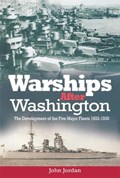This fascinating study of post-WWI naval powers reveals how international peace treaties influenced the design and engineering of modern warships.
The Washington Naval Treaty of 1922 was designed to prevent an arms race between the major naval powers after the First World War. But the new constraint inspired ingenious attempts to maximize the power of ships built within the treaty’s restrictions. By effectively banning the construction of new battleships for a decade, the signatories shifted their focus to the design and construction of large cruisers.
In Warships After Washington, naval historian John Jordan examines the political and strategic background of the Washington Naval Treaty and the subsequent London Treaty of 1930. He then presents a detailed study of the types of warships built by the navies of Britain, the USA, Japan, France. The treaties influenced naval engineering across the board—from the development of capital ships and cruisers to super-destroyers, aircraft carriers, and large submarines.

